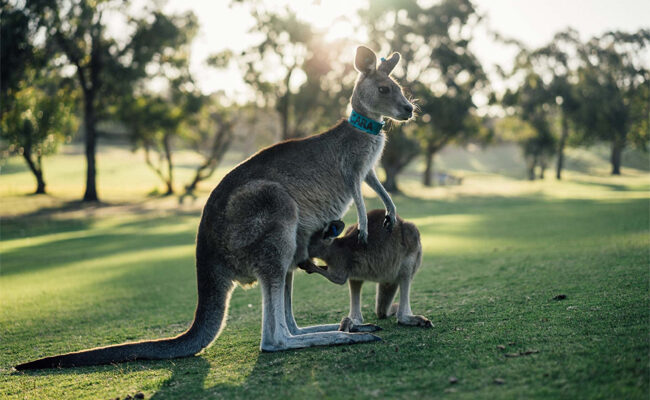
There is some uncertainty about the hottest day ever recorded for the entire continent of Australia, but many agree is was January 2, 1960. This day, it was a whopping 50.7°C (123.3°F). December, January, and February are the hottest months in Australia, and the northern part of the country experiences year-round warm temperatures.
In the summer of 2012-2013, Australia experienced what came to be known as the Angry Summer. 123 weather records were broken during a 90-day period.
Whether or not this coming summer is record-breaking, Australian summer is always a force to be reckoned with.
If you’re traveling to Australia during the summer, it’s a good idea to learn about how to deal with the extreme heat. Let’s take a look at seven tips to help keep you cool even when the sun is blazing.
1. Stay Hydrated
It’s always important to make sure that you are drinking enough water, but it’s most essential during the extreme heat of the summer. When your body doesn’t have enough water, it’s much easier to get weak, exhausted, and even increases your risk of passing out.
You and your family members should each be drinking at least two liters of water every day. If you are going to be participating in physical activities, you likely want to drink more than that.
Consider investing in a high-quality stainless steel water bottle so you can keep mother with you everywhere you go. Get into the habit of sipping water constantly throughout the day and you likely won’t have to worry about getting dehydrated.
2. Protect Yourself From the Sun
When you are going to be out in the sun during summer in Australia, you’re going to want to protect yourself from its harsh rays. The popular “slip, slap, slap” Australian campaign reminds people of the importance of sipping on a shirt, slapping on some sunscreen, and slapping on a hat.
The slogan has since been extended, encouraging individuals to “slide” on sunglasses and “seek” shade. When the sun is intense, you want to make sure that your head, skin, and eyes are protected.
3. Spend Time Outside During the Cooler Hours
The heat of Australia summer months doesn’t mean that you have to spend all of your time inside. However, you should try and spend your outdoor time early in the morning before the sun gets so brutally hot. You might also choose to spend time out in the evening after the sun has gone down.
If you are going to be doing physical activity or prolonged outdoor activity, you’ll want to take plenty of short breaks. During this time, catcher best, drink water, and rest under some shade. This will allow your body some time to recover and cool down.
The hottest hours of the day are typically between noon and 5 PM. During this time, it is best to find an airy or air-conditioned space to be. You might consider ducted air conditioning in your home to keep each room at the ideal temperature at all times.
4. Check the Forecast
Before you head out to go for a road trip, swim, or hike, it’s always a good idea to check the forecast for the day. This allows you to adjust your schedule, physical exertion, and water intake based on how extreme the heat is supposed to be.
It’s also important to know that high Australia summer temperatures can cause issues for vehicles too. In fact, tires are much more likely to blow out when the temperature is above 45°C. If you are planning on offroading the Australian bush, it’s important to be prepared.
5. Learn About the Symptoms of Heat Exhaustion
High temperatures, inadequate hydration, and typical exertion can lead to heat exhaustion. Heat stroke is more severe than heat exhaustion, but that doesn’t mean it should be taken seriously and dealt with immediately.
Some of the symptoms of heat exhaustion include:
- Headache
- Excessive sweating
- Nausea
- Dizziness
- Muscle cramps
- Fatigue
- A weak, rapid pulse
- Lightheadedness
People who are suffering from this condition can also have goosebumps and moist, cool skin when exposed to heat.
6. Stay Alert For Bush Fires
If you are traveling to Australia for a vacation, you might find yourself googling things like “what is it summer in Australia?” If you are not from down under, it’s easy to forget that the northern hemisphere’s winter is the southern hemisphere. Summer
During Australian summers, bushfires are much more likely to occur. During the season, there is a complete fire ban in most outdoor areas. If you’re going to go camping, make sure you know whether or not it’s safe to start a fire. You should always know the local emergency numbers if you are going camping and you have a plan of action in case of a bushfire.
7. Eat Light Meals
What you eat can have a major impact on how you feel and how well you deal with the extreme heat of Australian summer. It’s a good idea to choose frequent, light meals. This allows your body to gain the essential nutrients and minerals it needs while also staying active.
Highly processed or heavy foods tend to make you lethargic. Instead, choose fresh and healthy foods like fresh juices, fruits, salads, cold pasta and rice dishes, and nuts.
How Will You Spend Your Australian Summer?
Australian summer temperatures are no joke. If you aren’t used to the heat of the summer in Australia, you might just catch you off guard. It’s important to take it seriously, as heat exhaustion and heat stroke are serious conditions that can adversely affect your health.
Following the seven tips can help you have a safe, enjoyable summer free from sunburn, heat exhaustion, and other unfortunate consequences.
Did you find this article on Australian summer interesting? If so, be sure to check out the rest of our blog for more fascinating and informative content!
Leave a Reply